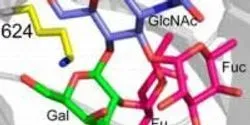Enzymes

With the aid of X-ray crystallography, researchers at the University of Michigan have revealed the structures of two closely related enzymes that play essential roles in the body's ability to metabolize excess lipids, including cholesterol.

Bacteria may not have brains, but they do have memories, at least when it comes to viruses that attack them. Many bacteria have a molecular immune system which allows these microbes to capture and retain pieces of viral DNA that they have encountered in the past, in order to recognize and destroy it when it shows up again.

A team led by structural biologists at The Scripps Research Institute (TSRI) has taken a big step toward understanding the intricate molecular mechanism of a metabolic enzyme produced in most forms of life on Earth.

Enzymes are catalysts that speed up chemical reactions in living organisms and control many cellular biological processes by converting a molecule, or substrate, into a product used by the cell. For scientists, understanding details of how enzymes work is essential to the discovery of drugs to cure diseases and treat disorders.

Mimicking natural evolution in a test tube, scientists at The Scripps Research Institute (TSRI) have devised an enzyme with a unique property that might have been crucial to the origin of life on Earth.














